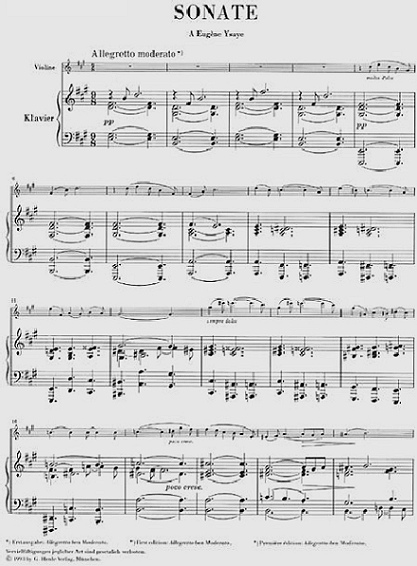"音樂...幫助我墜入我的自身裡, 發現新的物事, 這種東西我在生活裡, 行旅中遍尋不著;
對它的渴望卻因著這一股響亮的浪潮, 而重新在心底燃起, 陽光燦爛的潮波此時正好止於我的足下"(女囚)
普魯斯特自許, 也的確使用了天賦的敏感, 來記錄這些樂音; 事實上, 他也反覆訓練自己去"聽見它們" ; 普魯斯特把這種對音樂的漸層感受, 置於"斯萬之愛"中, 一段凡德伊寫的小提琴奏鳴曲, 成了斯萬對奧黛特愛情的苗火, 煙花 , 以及墓誌銘; 這些個有名的樂段 (The Little Phrase), 根據凡德伊原型和普氏對它的敘述細節, 可能是採擷自
法朗克A大調小提琴奏鳴曲- Franck Sonata for Piano and Violin in A major 第九小節一開始(可能性最高, 請見下), 法朗克A大調小提琴奏鳴曲正是版主年少輕狂時的最愛, 綿密幽遠的情緒, 始於暗流迷霧繾綣, 轉為激浪拍岸的淋漓, 半音階式的愛情, 似能深植入筋骨肌理, 在與樂音陷溺熱戀之時, 當時身旁的任何異性, 都可能無緣由地變成愛人罷 。
聖桑D小調小提琴奏鳴曲-- Saint-Saens Sonata for Piano and Violin no. 1 in D minor, op. 75 慢板一開始的高音( 一說為第三號, 但此曲並不受重視鮮少被演奏)
| Saint-Saëns was a child prodigy who, at age four and a half, appeared as pianist in a Beethoven violin sonata. By twenty-one, he held the post of organist at a major Parisian church and began years as a successful composer. In later life, he brought French music an international reputation touring as pianist and organist at the start of the twentieth century. He played in the United States twice, with an honored presence at the Pan-Pacific Exposition in San Francisco in 1916. Throughout his compositional life, he provided elegant examples of music in all its forms: opera (Samson and Delilah); symphonies (Symphony No. 3, The “Organ” Symphony); concertos (both piano and violin), and chamber works. He himself wrote: “The artist who does not feel completely satisfied by elegant lines, by harmonious colors, and by a beautiful succession of chords does not understand the art of music.” His Sonata No. 1 surely exemplifies the essence of his words. But how to define “elegance”? Just listen to the piano and its often-rippling undercurrent to the long violin melodic line. This is elegance. Written in four movements, Sonata No. 1 appears to be in two parts because Saint-Saëns links the first two movements, pauses, then joins the allegretto with the finale. Perhaps the word “caressing” bests describes the instruments in their quieter moments, a word not unrelated to the Saint-Saëns’ world of romanticism. Midway in the final movement, the music erupts with energy and impetus. “The brilliance of the finale compensates for the pale coloring of the other movements,” wrote one critic. The contrast is almost startling, but consistent with a man whose training as an organist knew the value of a radiant ending. |
佛瑞的升F大調敘事曲-- Faure Ballade in F sharp major op. 19.。

(法朗克A大調小提琴奏鳴曲一開始)

本文於 2010/02/20 21:37 修改第 9 次